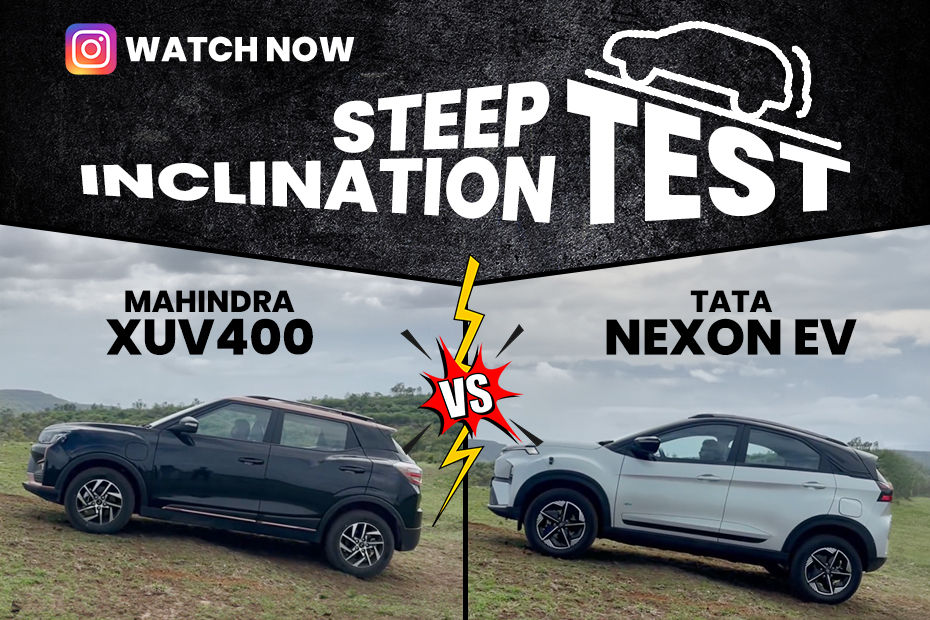Watch: Mahindra XUV400 vs Tata Nexon EV: Which EV Performs Better In An Incline Test?
Modified On Jun 21, 2024 04:02 PM By Samarth
- Write a comment
Both EVs were tested under identical conditions, yet only one successfully cleared the challenge on its first attempt
With the rise in popularity of electric vehicles, one key aspect of the performance of EVs is how well they handle steep inclines, a crucial factor for many drivers in hilly areas. Watch this video where we put two EVs: the Mahindra XUV400 and the Tata Nexon EV, to the test in order to demonstrate which one performs well on a steep incline challenge.
A post shared by CarDekho India (@cardekhoindia)
Implementation
During our test, we drove the vehicles up a slope on an off-road patch, to evaluate the performance of their hill-hold assist function. Initial performance of both the EVs was the same. To add to the challenge, we applied the brakes midway on the incline with auto hold engaged. It is worth mentioning here that Nexon EV gets hill-hold assist standard across all the variants while XUV400 offers it in top-spec variant only.

Upon releasing the brakes and moving again, the XUV400 tackled the slope smoothly, but the Nexon EV faced initial difficulty gaining traction. We had to roll it back to regain momentum before it could successfully climb the incline.
The Mahindra XUV400, with its higher power and torque, had a slight advantage in maintaining speed and handling the steepest inclines more effortlessly. The Mahindra SUV maintained a consistent speed and showed no signs of struggle on the slopes. However, the Tata Nexon EV, because of its slightly lower power and torque, didn't get over the incline in the first go.
Also Read: Mahindra XUV400 Has Slightly Longer Wait Times Than Tata Nexon EV This June
Powertrain
Here is the detailed information about the powertrain of both the EVs that we tested:
| Specifications |
Tata Nexon EV Long Range |
Mahindra XUV400 EL Pro |
| Battery Pack |
40.5 kWh |
39.5 kWh |
| No of Electric Motor |
1 |
1 |
| Power |
144 PS |
150 PS |
| Torque |
215 Nm |
310 Nm |
| Claimed Range |
465 km (ARAI) |
456 km (MIDC) |
Both the EVs, in their fully loaded variants, have similarly sized battery packs. That said, the XUV400 is the winner when it comes to the performance, with 6 PS and nearly 100 Nm additional output over the Nexon EV.

Meanwhile, in the lower variants, the Nexon EV is equipped with a 30 kWh battery generating 130 PS and 215 Nm, providing a claimed range of 325 km. In comparison, the lower variant of the XUV400 features a 34.5 kWh battery pack, delivering 150 PS and 310 Nm, with a claimed range of 375 km.
Price and Rivals
| Tata Nexon EV |
Mahindra XUV400 |
| Rs 14.49 lakh to Rs 19.49 lakh |
Rs 15.49 lakh to Rs 19.39 lakh |
All prices, ex-showroom pan-India
The entry-level variant of the Tata Nexon EV is Rs 1 lakh more affordable than the corresponding variant of the Mahindra XUV400. Whereas, in their top-spec variants, the Nexon EV is the costlier EV of the two. Both these EVs serve as an affordable alternative to the MG ZS EV and Hyundai Kona Electric.
Follow CarDekho's WhatsApp channel for latest Automotive updates
Read More on : Mahindra XUV400 EV Automatic
3 out of 3 found this helpful
















